|
| From Bohmer (2002) |
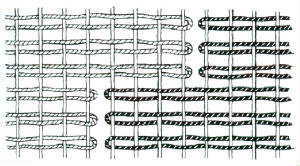
|
| Kilim technique |
| From Bohmer (2002) |
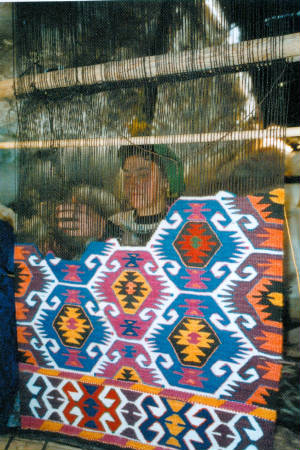
|
| From Bohmer (2002) |
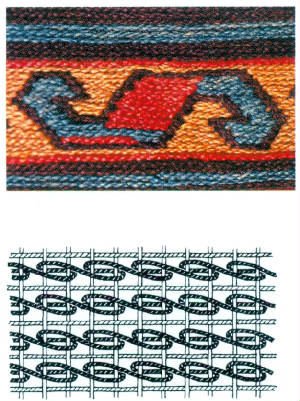
|
| Soumak technique |
| From Bohmer (2002) |
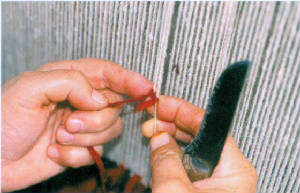
|
| Pile carpet |

|
| Turkish Knot (Left) & Persian Knot (Right) |
| Tribal woman displaying the art of spinning |
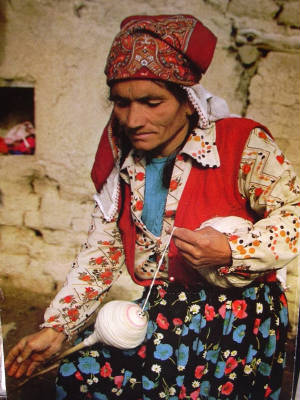
|
|
 |
 |
 |
Various Methods of Weaving
Kilim:
Kilim is the typical flat-weave carpet made from interweaving
various colored weft and warp threads into numerous motifs. (To learn about motifs, click here ).
Cicim (jijim):
Cicim is a method of weaving done with
different coloured design threads applied and tightened between weft and warp threads. Cicim is a kind of weaving which is
applied on the reverse. Cicim weavings whose weft is composed of bristles are very common. Fabric bags, tablecloths, bridal
sacks, prayer sheets, pillows and quilts are all made from cicim weaving.
Zili:
Design threads are applied three on the surface and one
below the surface in their own design area. After the line is completed, one or more wefts are applied and tightened. In diagonal
designs, this process is continued with the sliding of the thread on each line. Sometimes both diagonal and perpendicular
designs are applied in the same weaving.
Zili has a hard and rough appearance and is still produced by nomadic
shepherd peoples. Zilis are preferred for making various tents, sacks, cushions, pillows and mats.
Sumak / Soumak:
In sumak weaving, design threads are continously
wrapped around the warp loops in the same colored design area. While being wrapped around the warps in the same area, threads
may also be wrapped in other design areas by reversing or going up the sides. Design threads create reliefs on the surface
of the cloth. Essentially, it is a brocade method.
It is preferred in the making of prayer sheets, pack saddles
and mats.
Pile Carpets/Rugs:
A warp skeleton and every double thread in
the skeleton is tied with silk or floss silk by means of various techniques and are tightened with the weft thread and kirkit
(comb). In Turkey, two-wefted rugs are generally more common. After completing a few lines, weaving is cut to the desired
length with the help of rug scissors. These can also be used as mats, coverings,pillows, etc.
Two types of knots
are used in pile carpet weaving. The first type is the Turkish knot(double knot) technique. There are two types of Turkish
knot. In Central Anatolia, first the front then the rear double warp is wrapped around with the thread. In Western Anatolia,
the reverse procedure is carried out. These two types do not differ in quality. The second type is the Persian Knot (single
knot) technique. This takes its name from the fact it was first used in Western Iran. In this knot, the thread is only tied
to the front part of the double warp, then passed behind the other warp and tightened by pushing downwards.
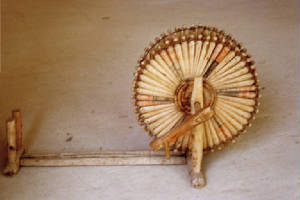
|
| Tools have not changed for a thousand years. |
|
 |
 |
 |
|
| Combs, shuttles, and other weaving implements |
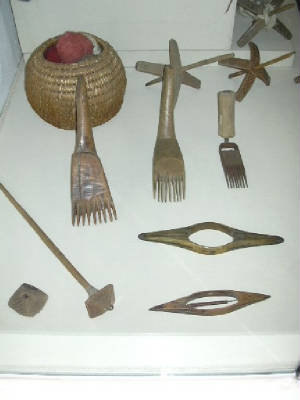
|
Regional Differences
As a rule, tribal carpets can be divided into four main groups based on their region of origin: Caucasian,
Central Asian (Turkestan), Persian, and Anatolian (Turkish).
Caucasian
Caucasian
rugs are from the region south of Russia, near the Caucasus Mountains, between the Black and Caspian Seas. This area includes
the countries of Georgia, Armenia, and Azerbaijan. There are approximately 350 different tribes, speaking 150 different dialects
in this area. Caucasian rugs, even though made by different weaving groups, still have very common characteristics. Some Caucasian
styles include the Kazak, Karabagh, Gendje, Talish, Shirvan, Baku, Kuba and Daghestan.
Central Asian
There are many different cultural groups in Central Asia, with distinct characteristics for each group. Some of the
cultural groups are Turkmen (subgroups are Tekke, Salor, Chodor, Yomut, and Ersari), Uzbeks, Kazakhs, Kyrgyzs, Tajiks, Baluch,
and Arabs.
Persian
Renowned for their rich colors, Persian carpets are distinctive
for its floral and other naturalistic designs. Major weaving centers are Arak, Ardebil, Bijar, Hamadan, Esfahan, Kashan,
Kerman, Mashhad, Nain, Qom, Sanandaj, Shiraz, Tabriz, Tehran, Yazd, and Zanjan. There are many other centers such as Afshar,
Baluch, Qashqai, and Senneh.
Anatolian
Anatolian (Turkish) carpets tend to come in
smaller sizes, with the exception of Ushaks. The majority of Anatolian carpets are prayer rugs with the distinctive mihrab
motif. Another characteristic of Anatolian rugs is their rich and colorful palette similar to Caucasian rugs. Most
Anatolian carpets, with the exception of Hereke and Ushak, seem to be geometric and very much influenced by Caucasian designs.
The two sub-styles mentioned above tend to be more curvilinear and have been influenced by curvilinear Persian styles. Due
to religious beliefs, naturalistic living motifs such as humans or animals, and the sacred color green are rarely seen in
older Anatolian rugs. However, today, both living creatures and the color green can be found in these rugs. Within Turkey,
there are numerous regions of carpet weaving, each with their own color combinations and designs. Some of the main carpet
production areas in Turkey are Uşak, Konya, Bergama, Hereke, Gördes, Kula, Ladik, Sivas, Milas, Antalya, Fethiye,
Kirsehir, Niğde, Kayseri and Isparta.
|
 |
|
|
|

